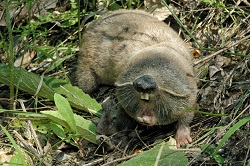EU researchers show that mole rat society is based on age, not on caste
Mole rats, including the naked mole rat, live in underground colonies and the majority of the rats in the colonies are ‘workers’, with only one female (‘the queen’) and one male responsible for breeding, thus having a rigid social structure which is more associated with insects such as bees and ants in the public consciousness. All individual mole rats cooperate by digging large underground tunnels systems to forage for food, and if a large food source is found, this is then shared with the entire colony. ‘Queens’ and the reproductive male remain in their roles for their entire life after they have achieved this position. When a ‘queen’ dies, the strongest and largest worker is most likely the prime candidate for inheriting the breeding position. Earlier studies suggested that non-reproducing mole rats could be divided into non-workers, infrequent workers and frequent workers and that most individual rats stay a member of a particular caste for the entirety of their lives. It was commonly believed that each individual would focus solely on a particular task - digging, nest building or colony defence. However, in a new study published in ‘Proceedings of the National Academy of Sciences’, researchers from the Department of Zoology at the University of Cambridge, and funded through the European Research Council’s (ERC) THCB2011 project, have shown that in Damaraland mole rats, the contributions of individuals to cooperate activities change with age. Individual differences in behaviour that appeared to be caste-based are in-fact age-related changes in behaviour. It is still to be confirmed that variation in behaviour between naked mole rats is also a consequence of age, but the researchers are confident that this is indeed likely. ‘In some ants, aphids and termites, individuals are born into castes that fulfil certain roles, such as soldiers or workers,’ explains Dr. Markus Zöttl, first author of the study explained. ‘Initially, everyone thought that this was only found in social invertebrates, like ants and bees, but in the eighties, the discovery of the social behaviour of mole rats changed this view. Social mole rats were thought to be unique among vertebrates, in that they also had castes. To understand this fully, what we needed was long-term data on many mole rats over extended periods of their lives.’ In order to gather such data and study mole rat behaviour in more detail, the research team, led by Professor Timothy Clutton-Brock, THCB2011’s principal investigator, built a laboratory in the Kalahari Desert, where Damaraland mole rats are native. They then established multiple colonies of mole rats in artificial tunnel systems. Over a period of three years, they followed the lives of several hundred individual mole rats to document how their behaviour changed as they aged. All individuals were weighed and observed regularly. It was through this detailed documentation that the team realised that mole rats are generalists, not specialists as previously thought - they play different roles as they get older, rather than remain in one set and caste-defined role for their entire lives. Thus, unlike insects such as ants and termites, all mole rats are involved in a range of different activities, and their contributions to cooperate activities increases with age. ‘As Damaraland mole rats do not have castes, this may mean that castes are only found in social invertebrates and have not evolved in any vertebrates,’ adds Dr. Zöttl. ‘Mole rat social organisation probably has more in common with the societies of other cooperative animals, such as meerkats and wild dogs, than with those of social insects.’ For more information please see: CORDIS project page
Countries
United Kingdom



